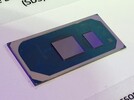Intel UHD Graphics G7 (Lakefield GT2 64 EU) vs Intel UHD Graphics (Jasper Lake 16 EU) vs Intel Iris Plus Graphics G7 (Ice Lake 64 EU)
Intel UHD Graphics G7 (Lakefield GT2 64 EU)
► remove from comparison
The Intel UHD Graphics G7 (Lakefield GT2 with 64 EUs) is an integrated graphics card in the Lakefield SoCs (e.g. Core i7-L16G7) for laptops. It offers no dedicated graphics memory (no eDRAM cache like the Intel Iris Graphics 655 predecessor of the Coffee Lake SoCs). The clock rate ranges between 200 MHz (guaranteed base clock) up to 500 MHz (boost). The TDP of the whole SoC is specified at 7 Watt.
| Intel Gen.11 Graphics Cards | Cores | Base | Boost |
|---|---|---|---|
| Intel Iris Plus Graphics G7 Ice-Lake | 64 EUs | 300 MHz | 1100 MHz |
| Intel Iris Plus Graphics G4 Ice-Lake | 48 EUs | 300 MHz | 1050 MHz |
| Intel UHD Graphics G1 Ice-Lake | 32 EUs | 300 MHz | 1050 MHz |
| Intel UHD Graphics G7 Lakefield | 64 EUs | 200 MHz | 500 MHz |
| Intel UHD Graphics G4 Lakefield | 48 EUs | 200 MHz | 500 MHz |
The GPU performance is similar to the old Intel HD Graphics 630 and therefore only some low demanding games like League of Legends should run with the UHD Graphics.
A special new feature of the Gen11 graphics card is the new Variable Rate Shading (VRS) support. With it game designers can decide where to spend shading time and e.g. shade object in the background or behind fog with less resolution (up to using only one source for a 4x4 block). With this technique early results show up to 1.3x performance in Unreal Engine POC and 1.2x speedup in Civ 6. Up to now VRS is only supported by the new Nvidia Turing architecture (GTX 1650 and up).
The Lakefield SoCs and therefore the integrated GPU are manufactured in the modern 10nm process at Intel that should be comparable to the 7nm process of TSMC.
Intel UHD Graphics (Jasper Lake 16 EU)
► remove from comparison
The Intel UHD Graphics 16 EUs (Jasper Lake, Gen. 11) is an integrated graphics card in the Jasper Lake Celeron SoCs for laptops and small desktops. It is the low end GPU version in the Jasper Lake series (Celeron Dual-Cores) and offers only 16 of the 32 EUs (Execution Units / Shader Blocks). It offers no dedicated graphics memory and the clock rate depends on the processor model. At launch there are two Celeron models (N4500 with 6W and N4505 with 10W) clocked at 350 - 750 MHz.
Thanks to the improved architecture and more EUs, the UHD Graphics is clearly faster than the old Gemini Lake SoCs (e.g. UHD Graphics 600).
A special new feature of the Gen11 graphics card is the new Variable Rate Shading (VRS) support. With it game designers can decide where to spend shading time and e.g. shade object in the background or behind fog with less resolution (up to using only one source for a 4x4 block). With this technique early results show up to 1.3x performance in Unreal Engine POC and 1.2x speedup in Civ 6. Up to now VRS is only supported by the new Nvidia Turing architecture (GTX 1650 and up).
Another improved hardware piece is the integrated video de- and encoder that was improved significantly according to Intel. They did not specify any more details, but the previous generation was able to decode VP9 and H.265/HEVC in Main10 profile with 10 bit color depth using the dedicated hardware.
The Jasper Lake SoCs and therefore the integrated GPU are manufactured in the 10nm process (like Ice Lake probably) at Intel that should be comparable to the 7nm process of TSMC.
Intel Iris Plus Graphics G7 (Ice Lake 64 EU)
► remove from comparison
The Intel Iris Plus Graphics G7 (Ice Lake with 64 EUs) is an integrated graphics card in the Ice Lake SoCs (10th generation core 10xxG7) for laptops. It offers no dedicated graphics memory (no eDRAM cache like the Intel Iris Graphics 655 predecessor of the Coffee Lake SoCs). The clock rate depends on the processor model. At launch it looks like all models have a 300 MHz base clock and only differ in the boost clock (1050 - 1100 MHz). Another difference is the TDP as it can be configured from 12 - 25 Watt in the 15 Watt U-models and maybe even higher in the 25 Watt models that will come later.
The performance should be slightly above a AMD Radeon RX Vega 10 integrated GPU in the Ryzen 7 3000 series processors. e.g. Intel showed a Intel Iris Plus G7 against a Ryzen 7 3700U both configured at 25 Watt TDP and the Ice Lake GPU was able to beat the Vega 10 slightly in all games. Compared to the previous generation, Intel talks about a 2x performance improvement but wont specify the exact model. All in all the GPU should be positioned in the entry level of dedicated GPUs (Nvidia GeForce MX150 level?) and therefore most suited for less demanding games like Fortnite, Rainbow 6 Siege, or Rocket League at reduced details. The theoretical performance of the Chip is specified with 1.12 TFLOPS (FP32) and 2.25 TFLOPS (FP16) when running at 1.1 GHz.
Compared to the older Gen.9 graphics (e.g., UHD Graphics 620 in Whiskey Lake), Gen.11 is using a wider architecture and also has 3 MB dedicated L3 cache near the GPU.
A special new feature of the Gen11 graphics card is the new Variable Rate Shading (VRS) support. With it game designers can decide where to spend shading time and e.g. shade object in the background or behind fog with less resolution (up to using only one source for a 4x4 block). With this technique early results show up to 1.3x performance in Unreal Engine POC and 1.2x speedup in Civ 6. Up to now VRS is only supported by the new Nvidia Turing architecture (GTX 1650 and up).
Another improved hardware piece is the integrated video de- and encoder that was improved significantly according to Intel. They did not specify any more details, but the previous generation was able to decode VP9 and H.265/HEVC in Main10 profile with 10 bit color depth using the dedicated hardware.
The Iris Plus G7 supports three display pipes that can each output 5K60 signals (via DisplayPort 1.4 HBR3 or HDMI 2.0b). Combining two pipes, the chip is capable to output 8k content.
The Ice Lake SoCs and therefore the integrated GPU are manufactured in the modern 10nm process at Intel that should be comparable to the 7nm process of TSMC.
| Intel UHD Graphics G7 (Lakefield GT2 64 EU) | Intel UHD Graphics (Jasper Lake 16 EU) | Intel Iris Plus Graphics G7 (Ice Lake 64 EU) | |||||||||||||||||||||||||||||||||||||||||||||||||||||||||||||||||||||||||||||||||||||||||||
| Gen. 11 Series |
|
|
| ||||||||||||||||||||||||||||||||||||||||||||||||||||||||||||||||||||||||||||||||||||||||||
| Codename | Lakefield GT2 | Gen. 11 | Ice Lake G7 Gen. 11 | ||||||||||||||||||||||||||||||||||||||||||||||||||||||||||||||||||||||||||||||||||||||||||
| Architecture | Gen. 11 Ice Lake | Gen. 11 | Gen. 11 Ice Lake | ||||||||||||||||||||||||||||||||||||||||||||||||||||||||||||||||||||||||||||||||||||||||||
| Pipelines | 64 - unified | 24 - unified | 64 - unified | ||||||||||||||||||||||||||||||||||||||||||||||||||||||||||||||||||||||||||||||||||||||||||
| Core Speed | 200 - 500 (Boost) MHz | 350 - 800 (Boost) MHz | 300 - 1100 (Boost) MHz | ||||||||||||||||||||||||||||||||||||||||||||||||||||||||||||||||||||||||||||||||||||||||||
| Memory Type | DDR4 | DDR4 | |||||||||||||||||||||||||||||||||||||||||||||||||||||||||||||||||||||||||||||||||||||||||||
| Shared Memory | yes | yes | yes | ||||||||||||||||||||||||||||||||||||||||||||||||||||||||||||||||||||||||||||||||||||||||||
| API | DirectX 12_1, OpenGL 4.5 | DirectX 12_1, OpenGL 4.5, OpenCL 1.2 | DirectX 12_1, OpenGL 4.5 | ||||||||||||||||||||||||||||||||||||||||||||||||||||||||||||||||||||||||||||||||||||||||||
| Power Consumption | 7 Watt | 4.8 - 10 Watt | 12-25 Watt | ||||||||||||||||||||||||||||||||||||||||||||||||||||||||||||||||||||||||||||||||||||||||||
| technology | 10 nm | 10 nm | 10 nm | ||||||||||||||||||||||||||||||||||||||||||||||||||||||||||||||||||||||||||||||||||||||||||
| Features | QuickSync | QuickSync | QuickSync | ||||||||||||||||||||||||||||||||||||||||||||||||||||||||||||||||||||||||||||||||||||||||||
| Date of Announcement | 28.05.2020 | 11.01.2021 | 28.05.2019 | ||||||||||||||||||||||||||||||||||||||||||||||||||||||||||||||||||||||||||||||||||||||||||
| Displays | 3 Displays (max.) | ||||||||||||||||||||||||||||||||||||||||||||||||||||||||||||||||||||||||||||||||||||||||||||
| Predecessor | UHD Graphics 600 |
|
|
| ||||||||||||||||||||||||||||||||||||||||||||||||||||||||
Benchmarks
3DM Vant. Perf. total + Intel UHD Graphics (Jasper Lake 16 EU)
Cinebench R15 OpenGL 64 Bit + Intel UHD Graphics G7 (Lakefield GT2 64 EU)
GFXBench T-Rex HD Offscreen C24Z16 + Intel UHD Graphics (Jasper Lake 16 EU)
Average Benchmarks Intel UHD Graphics G7 (Lakefield GT2 64 EU) → 100% n=20
Average Benchmarks Intel UHD Graphics (Jasper Lake 16 EU) → 60% n=20
Average Benchmarks Intel Iris Plus Graphics G7 (Ice Lake 64 EU) → 186% n=20
* Smaller numbers mean a higher performance
1 This benchmark is not used for the average calculation
Game Benchmarks
The following benchmarks stem from our benchmarks of review laptops. The performance depends on the used graphics memory, clock rate, processor, system settings, drivers, and operating systems. So the results don't have to be representative for all laptops with this GPU. For detailed information on the benchmark results, click on the fps number.

Ready or Not
2023
EA Sports WRC
2023
Total War Pharaoh
2023
EA Sports FC 24
2023
Counter-Strike 2
2023
Armored Core 6
2023
Dead Island 2
2023
Company of Heroes 3
2023
Sons of the Forest
2023
Atomic Heart
2023
Hogwarts Legacy
2023
Dead Space Remake
2023
High On Life
2023
The Quarry
2022
Vampire Bloodhunt
2022
Ghostwire Tokyo
2022
Elden Ring
2022
Forza Horizon 5
2021
Riders Republic
2021
Back 4 Blood
2021
Alan Wake Remastered
2021
FIFA 21
2020
Serious Sam 4
2020
Crysis Remastered
2020
Death Stranding
2020
F1 2020
2020
Gears Tactics
2020
Doom Eternal
2020
Hunt Showdown
2020
Escape from Tarkov
2020
Need for Speed Heat
2019
GRID 2019
2019
FIFA 20
2019
Borderlands 3
2019
Control
2019
F1 2019
2019
Rage 2
2019
Anno 1800
2019
The Division 2
2019
Dirt Rally 2.0
2019
Anthem
2019
Far Cry New Dawn
2019
Metro Exodus
2019
Apex Legends
2019
Just Cause 4
2018
Battlefield V
2018
Forza Horizon 4
2018
Monster Hunter World
2018
Far Cry 5
2018
X-Plane 11.11
2018
Fortnite
2018
Destiny 2
2017
ELEX
2017
Team Fortress 2
2017
Rocket League
2017
Prey
2017
For Honor
2017
Resident Evil 7
2017
Overwatch
2016
Doom
2016
Rainbow Six Siege
2015
World of Warships
2015
Metal Gear Solid V
2015
Dota 2 Reborn
2015
The Witcher 3
2015
GTA V
2015
Sims 4
2014
BioShock Infinite
2013
Tomb Raider
2013
Guild Wars 2
2012
Counter-Strike: GO
2012
Diablo III
2012Average Gaming Intel UHD Graphics G7 (Lakefield GT2 64 EU) → 100%
Average Gaming 30-70 fps → 100%
Average Gaming Intel UHD Graphics (Jasper Lake 16 EU) → 83%
Average Gaming 30-70 fps → 91%
Average Gaming Intel Iris Plus Graphics G7 (Ice Lake 64 EU) → 230%
Average Gaming 30-70 fps → 272%
| Intel UHD Graphics G7 (Lakefield GT2 64 EU) | Intel UHD Graphics (Jasper Lake 16 EU) | Intel Iris Plus Graphics G7 (Ice Lake 64 EU) | |||||||||||||||||||
|---|---|---|---|---|---|---|---|---|---|---|---|---|---|---|---|---|---|---|---|---|---|
| low | med. | high | ultra | QHD | 4K | low | med. | high | ultra | QHD | 4K | low | med. | high | ultra | QHD | 4K | ||||
| F1 25 | |||||||||||||||||||||
| F1 22 | |||||||||||||||||||||
| Elden Ring | 5.18 | 15.5 | 12.7 | ||||||||||||||||||
| F1 2021 | 19 | ||||||||||||||||||||
| Total War: Three Kingdoms | 15.2 | 50 | 13 | 7 | 5 | ||||||||||||||||
| Shadow of the Tomb Raider | 7 | 26 | 14 | 13 | |||||||||||||||||
| Strange Brigade | 16 | 7 | 6 | 51 | 20 | 17 | 15.2 | ||||||||||||||
| Far Cry 5 | 7 | 22 | 12 | 10 | 11 | ||||||||||||||||
| X-Plane 11.11 | 17 | 9.61 | 9 | 12 | 9 | 8 | 29 | 16 | 15 | ||||||||||||
| Final Fantasy XV Benchmark | 6 | 3 | 2 | 19 | 10 | 8 | |||||||||||||||
| Dota 2 Reborn | 53 | 23 | 15 | 15 | 48 | 24 | 12 | 11 | 81 | 50 | 29 | 27 | |||||||||
| The Witcher 3 | 17 | 11 | 48 | 32 | 17 | 8 | |||||||||||||||
| GTA V | 13 | 25 | 5.59 | 40 | 38 | 13 | 4.9 | ||||||||||||||
| Counter-Strike: GO | 57.6 | 48.1 | 17.8 | 154.7 | 111.2 | 71.5 | 39.2 | ||||||||||||||
| Intel UHD Graphics G7 (Lakefield GT2 64 EU) | Intel UHD Graphics (Jasper Lake 16 EU) | Intel Iris Plus Graphics G7 (Ice Lake 64 EU) | |||||||||||||||||||
| low | med. | high | ultra | QHD | 4K | low | med. | high | ultra | QHD | 4K | low | med. | high | ultra | QHD | 4K | < 30 fps < 60 fps < 120 fps ≥ 120 fps | 2 1 | 2 | 2 | 1 | | | < 30 fps < 60 fps < 120 fps ≥ 120 fps | 10 2 | 5 1 | 5 | 2 | | | < 30 fps < 60 fps < 120 fps ≥ 120 fps | 5 4 1 1 | 7 3 1 | 9 1 | 6 1 | | |
For more games that might be playable and a list of all games and graphics cards visit our Gaming List








































